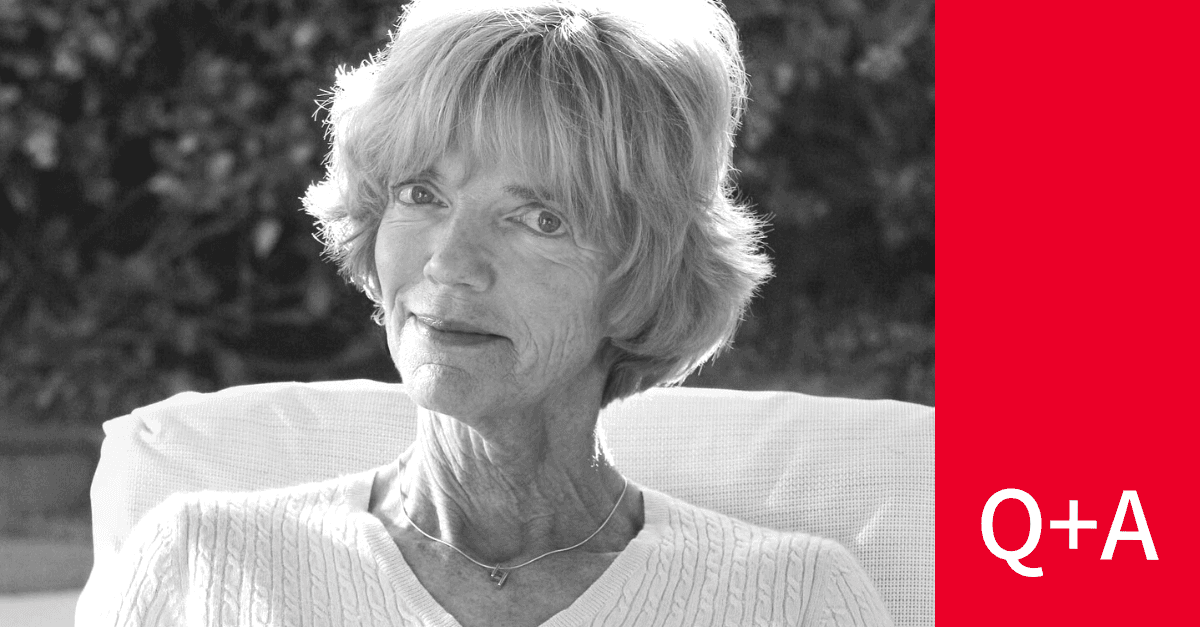Q&A with Dr. Newsha Ajami
Tell us about yourself – what is your background in and how did you end up in your current position?
I did my undergraduate, Master's, and PhD in civil and environmental engineering. As an undergrad, I was focused more on the civil engineering side – learning to design and build various kinds of infrastructure. One of the most important moments of my academic career was during my time in the Master's program at the University of Arizona, where I took a class in water policy. Until that point, I had given very little thought to water policy, governance, and regulations. Like most Americans, I just turned on the tap and there it was. I thought about the infrastructure essential to water delivery and wastewater management, but nothing beyond. This class, however, was very eye-opening for me: learning how water management is influenced by different laws, especially Western water laws, water rights, and the policy that is surrounding it. There and then I decided I would like to learn more about public policy surrounding water management and governance.
I came quickly to the realization that in the academic world, we build all these tools which don’t necessarily incorporate the policy and the human elements that are very much important to better-understanding outcomes, nor include the feedback loops to best inform decision-making. When I finished my PhD, learning more about public policy and truly immersing myself in it became my goal. I spent three years studying natural resource economics and building hydro-economic models at UC Berkeley. I also received a scholarship from the American Meteorological Society to participate in their science policy colloquium in Washington, D.C. – a two-week program to learn about the intersection of science and policy at various levels of the federal government. Later I applied for a fellowship with the California Council of Science and Technology, and ended up going to Sacramento, California as a Science Fellow to work for the state legislature. I worked on a broad range of issues related to climate, energy policy, and finance, in addition to land use and water governance. My year in Sacramento felt much like getting a second PhD, a fast-moving and dynamic crash course in public policy.
Ultimately, I built my career on that arc of how water resource management, water policy, economics, and social science meet with one another. I joined Stanford Woods Institute as a senior research fellow, and directed the Urban Water Policy Program. Around the same time I was appointed to the San Francisco Bay Regional Water Quality Control Board by the governor of California to protect and preserve waters of our state in the region.
Can you tell us about the Earth and Environmental Sciences Area at Lawrence Berkeley National Laboratory?
Our scientists at the Earth and Environmental Sciences Area at Lawrence Berkeley National Laboratory work on developing solutions to our most pressing environmental and energy challenges. There are teams of researchers working on climate science, hydrology, soil health, ecology, microbiology, geosciences, and much more. The research spans molecular to global scales and deep subsurface through atmosphere compartments.
There was a natural progression to where I currently am, part of EESA. My broad range of expertise and interdisciplinary background has provided me with the capacity to identify interlinks and provide a vision and build strategic efforts to produce impactful and innovative scientific solutions. I am very excited to put all this to work at LBL to help create strategic and forward-looking initiatives across the water, energy, and climate space. One of the areas I am focusing on is how to incorporate social equity and community knowledge, and environmental concerns into our project development and design. As many of our researchers are working on projects to enable our energy transition and achieve climate resilience, it is important in the process of scientific inquiry to consider the pathways to avoid and minimize both social and environmental impacts.
How has water resource planning and management shifted in the face of climate change?
The 20th century water infrastructure was underpinned by three assumptions: abundance, hydroclimatic stationarity, and perpetual growth of demand. Climate change has challenged these assumptions, with reliable water supplies becoming increasingly uncertain as precipitation patterns are altered and have become more unpredictable. Our quest for creating water abundance has proven to be unsustainable and has led to inefficient water use practices. In many cases, people do not know where their water comes from and when it goes after use, hence mindless consumption of this finite and precious resource.
Hydroclimatic stationarity is the concept that while there will be some interannual variability in our hydrologic cycle from year to year, the overall trends and statistical characteristics will stay the same over time. There was some flexibility built into the current infrastructure system and the governance models that overlay the system, but it certainly was not designed to handle the climatic and hydrologic extremes of today. For example, California has experienced two severe, multi-year droughts in the past decade: setting, and then breaking, a number of records for highest temperatures and lowest levels of precipitation. Then these events are compounded by disasters like a wildfire, which can impact water supplies, quality, and infrastructure – directly and indirectly. When there is rain, there is a trend towards extreme volumes; overwhelming our water infrastructure – such as wastewater treatment plants and dams. This is a scenario that we are very likely to see more of due to our changing climate. The water system and infrastructure were designed for averages, and we are in a time of extremes and high variability.
Finally, we have managed to decouple our economic and population growth from water use. We have managed to become more efficient and do more with less, our codes and standards have changed, and technological advancement has helped curb our water demand. In many cases, the perpetual demand growth has not happened.
It's also important to note that our 20th century mindset was centered around engineering our way out of the limitations imposed by nature: for example, humans moved water from water-rich areas to places with limited water. The fact is, infrastructure and policies, institutions, and governance structures that overlay it were not set up to deal with the challenges we are facing today. We are gradually recognizing that and are trying to work in harmony with nature to achieve our short-term and long-term water sustainability resilience goals. The enthusiasm around green and natural infrastructure is a result of this paradigm shift.
What are some of the leading efforts in water conservation you’ve seen?
Conservation and efficiency is often, rightfully so, centered around reducing outdoor and indoor water use to doing more with less, such as ripping out lawns and replacing them with native landscape, replacing inefficient appliances and fixtures, and preventing leaks. Las Vegas, last year, asked homeowners to remove all nonfunctional grass lawns by 2026. It seems something of a fool's errand to grow a lawn in the middle of a desert, but making that change on a policy level is a major milestone.
Something that people always overlook is how demand management is the cheapest, fastest, easiest way to reduce our environmental impact while enhancing supplies. Reducing water demand is very similar to how demand on the electrical grid was instituted during the 2000s. We swapped out light bulbs for more efficient CFL and LED bulbs, when we upgraded appliances, they did more with less energy. The same principles apply to water: high efficiency toilets, dishwashers and baths. Every time you flush your toilet, you’re doing so with drinkable water, which underwent intensive processes to be safe to drink. However, if we repurpose greywater, water that you’ve used to bathe or wash your clothes in, to flush your toilet, the demand on the system can go down by almost 20%-30%. San Francisco has an ordinance that would require buildings over 100,000 square feet to operate an onsite water reuse system within the building. My hope is that similar systems make their way into our homes someday as well. These efforts are much broader than conversation and efficiency. They fall under demand management strategies and help transition water users to both consumers and producers of water, changing the way we think of infrastructure and demand.
Both what happened in Las Vegas and San Francisco goes beyond technological advancement, but rather emphasizes the importance of change in public policy to ultimately make a difference. There will always be no shortage of the technologies, but to truly change the way we think about water security and access for water in the future will have to rethink water governance and policy. I think we need a serious public policy shift and reevaluate how water is governed and protected.
How are water and energy usage related, and will they become more intertwined in the future?
Water and energy are closely intertwined – potable water is energy intensive. If you use less water, then you need less energy to treat the water, distribute it, and heat it: so water efficiency can directly lead to energy savings. After the water is used, it then has to be carried away, and treated before it is put back into the environment; these processes are all energy intensive as well. On the other hand energy extraction, refining and production need water. In both carbon-intensive energy production and nuclear, there is a lot of heat generated in the process. Water is used to both cool the plants, but the energy is frequently created by the use of a steam-driven turbine.
For the energy transition, water will play a major role as well, in meeting rare material demands. Lithium (and other rare minerals) mining, extraction, refinery, and recycling take immense amounts of water, simultaneously presenting a polluter and a sudden increase in demand. We have a chance to be more intentional about a lot of things that we do as we enable our energy transition, and how you're doing it.
What old-school technology do you wish you could bring back?
I would say I would bring back landline phones. We all use our phones so much. Lately, this feels like we are not even truly connecting with people anymore, just swapping thumbs up and hearts and laughing faces. I miss remembering important phone numbers, and making time to talk with someone on the phone – it felt very intentional. I miss that human connection.




